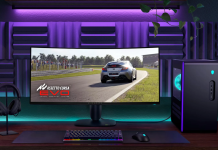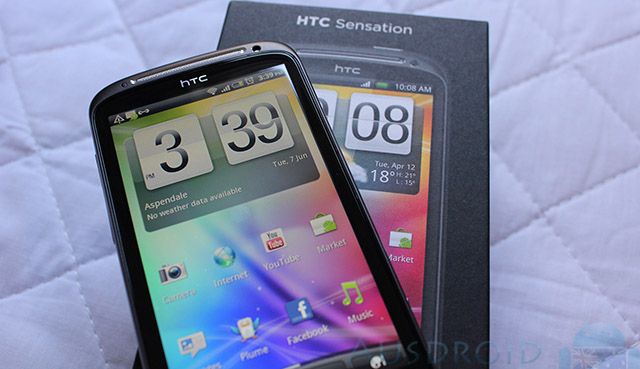
There’s been a lot of hype surrounding the HTC Sensation since it was first announced back in April, and for good reason; it’s HTC’s first dual-core device that will hopefully push them to the forefront of high-end devices once again. I can tell you now, that’s not the case. HTC seems to have given up on the hardcore Android users that pushed them to their current success and instead have turned to the average consumers who want flashy looking phones with colourful animations and absolute user-friendliness and I applaud HTC for that. So hit the break for my rundown of the HTC Sensation.
Pros..
- The qHD, Super TFT display — close to the best out there
- Sense UI is extremely user friendly for first-timers
- Instant-capture camera function, excellent video quality
- Fairly snappy 1.2GHz dual-core CPU
Cons..
- Not the greatest design, feels heavy
- “death-grip” does kill Wi-Fi in some normal use
- HTC have their own channel in the Market which removes the “your apps” icon
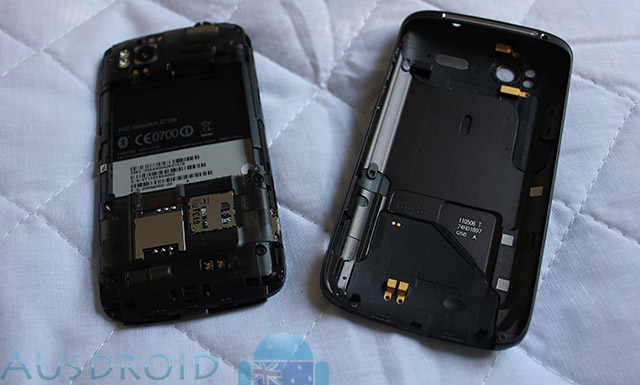
Hardware..
The Sensation ticks all the boxes when it comes to high-end hardware, you’ve got the 1.2GHz Dual-Core CPU, 8MP Camera w/ 1080p video, 4.3″ qHD Super TFT display as well as a fairly speedy 14.4Mbit downlink connection over 3G, depending on your network of course. The design of the Sensation is very sleek and good looking, especially with its uni-body aluminium back cover. Below the 4.3″ qHD display are 4 capacitive buttons: home, menu, back and search; above the screen is a VGA front-facing camera, ambient light and proximity sensors, and the phone speaker. There’s nothing on the left side of the device, which curves to fit nicely in your hand; on the right hand side is the volume rocker and micro-USB input which is for charging and outputting video via MHL. The power button and 3.5mm headphone jack sit at the top of the Sensation.
It weighs a fair bit heavier than the Galaxy S II thanks to the aluminium in its structure. There is a fair placing of plastic on the Sensation as well which is used to dissipate the heat that is produced by the dual-core CPU. The design also has its flaws, such as when your hand covers the Wi-Fi antennas on the rear of the device will cause Wi-Fi signal to drop and sometimes even cut out, this does happen in real-world use and you hold the phone in landscape mode with two hands on the rear of the device. Annoying.
Display..
Oh my goodness… The display on the Sensation is top-notch and in a way I think it’s the best screen in any current Android device, though I could be pushing the limits a bit there. Measuring in at 960×540 over a 4.3″ display, you get some pretty nice pixel density — 266ppi to be exact — and it’s extremely evident, small text is sharp, icons and images look superb and the colour production is quite nice, if not a bit washed out, which is to be expected of TFT. Colours aren’t as saturated as those on the Galaxy S II (powered by Super AMOLED +) and blacks aren’t as black, but it can certainly hold its own.
The glass over the display is curved upwards on the edges to leave a gap between the screen and any surfaces which may scratch it when lying face-down. The screen is actually not as wide as the Galaxy S II, but taller which gives you the 4.3″ measurement. HTC have also limited through their software, the number simultaneous touches on the screen, that being 4 at any one time compared to 10 on the Galaxy S II.
With this screen HTC are well in front of the qHD race, with the Atrix being abysmal and no one else really pushing qHD outside of America. However, I see Sony Ericsson and Samsung being massive competition to HTC on the qHD front in the near future, with Sony Ericsson’s Bravia Display technology making their screens look beautiful and Samsung’s Super AMOLED + is outstanding.
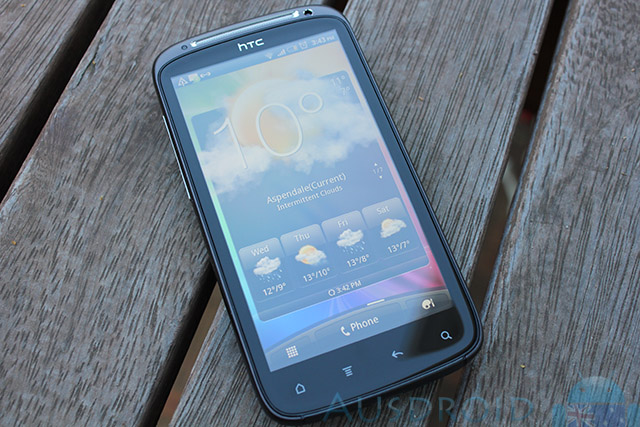
CPU..
Under the hood of the Sensation is Qualcomm’s first Dual-Core Snapdragon CPU which has been underclocked from 1.5GHz to 1.2GHz to increase battery life and reduce heat. It’s certainly not slow as it powers through whatever task you throw at it. Some consideration of speed also has to be given the qHD display it has to power as well as the resource hungry Sense UI which caused most of the slowdowns on the device.
We’ve also included some Quadrant and Neocore benchmarks in the benchmarking part of the review down the page a little further.
Camera..
There’s an 8MP shooter on the rear of the Sensation, which sits next to two LEDs, and a VGA camera at the front for video calls and all that good stuff. The quality of the rear camera is top-notch and the instant-capture feature is freakin’ amazing. Just to be able to take the photo of what you’re looking at the exact moment you hit the on-screen shutter button is great.
Video records at 1080p (1920×1080) @ 30fps and records audio in stereo thanks to the two microphones on the Sensation. If anything I do think the quality of the video recording is better than that of the Galaxy S II, but that’s subjective. As always there are some samples below.
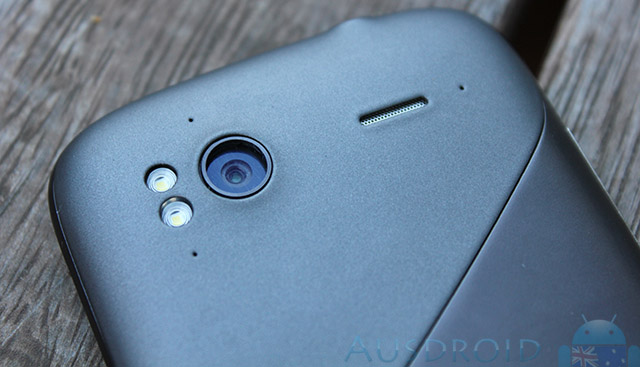
[nggallery id=79]
Battery
There’s only a 1520mAh battery on the back of the Sensation and it drains the life out of it fairly quickly. After leaving home at 7AM each morning and getting home at around 3:30PM, I would have to put it straight on the charger after that period of time with pretty intensive use (syncing, music, browsing). I don’t think HTC realise that with such a powerful processor pushing out enough to power a qHD display, it would need a lot of juice. Your mileage may vary, of course.
Telephony..
Surely we can phase this part of out of reviews? The Sensation makes and takes calls perfectly. There’s a second mic for noise cancelling which is an absolute must on phones these days, so it’s nice to see HTC putting it there. In call volume is clear and loud and the loudspeaker is exactly that.
The Sensation, in its current form, supports 14.4Mbit HSDPA and 7.56Mbit HSUPA which isn’t quite HSPA+ speeds and useless on Optus’ 7.2Mbit network, though I did peak at 7Mbit down fairly regularly during my time with the device.
Software
Sense UI is the kind of User Interface you either love or you hate with a passion, despite that, I feel that Sense UI v3.0 is extremely well designed and implemented. It’s all about flashy graphics, pseudo-3D widgets and overall making things easier and more appealing for the end user. For that reason I see the HTC Sensation being more aimed at the less tech-savvy user, not that there’s anything wrong with that; I applaud HTC for making such a high-end device that’s easy and appealing to use for the average consumer, but as we’re a site aimed at the more tech-savvy end of the consumer scale, I don’t know how many of you guys/girls would appreciate the over-done interface. Everything spins, flashes, twirls, glows and half the time you’re flying through clouds on the lockscreen, wallpaper or weather application.
The weather & clock widget on the home screen also makes weather-based sounds whenever you unlocked the device (outside of silent mode) which can be either irritating or a cool little gimmick. There are seven home screens, and you’re limited to that amount, so if you’re a massive fan of widgets and icons you may find yourself replacing Sense with a Launcher from the Android Market. The best part of Sense UI is that nearly everything is interactive, such as the messaging, email and twitter widgets, so that you can look through your interactions with others by swiping through the widgets on the home screen.
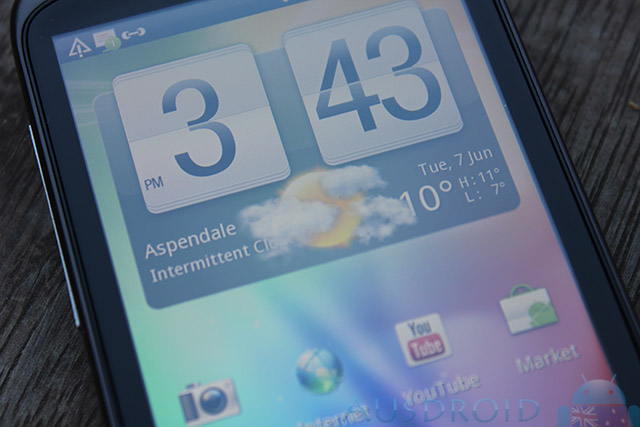
There is a downside to a UI this resource intensive: it tends to slow the device down at times, and with a 1.2GHz dual-core it’s hard to imagine why this still happens. When downloading and installing applications off the Android Market that phone comes to an almost complete stop, which is something that I’ve had happen on nearly every device I’ve used that had Sense UI on it. Even some of the HTC-built apps can get a little sluggish. But overall there aren’t a lot of HTC-built apps and everything downloaded off the market was nice and snappy for me.
As with nearly all HTC phones, the keyboard is once again top-notch. It responds quicker and more accurately than any other stock keyboard I’ve used and that’s been the case since the first keyboard on the HTC Hero back in the day. I did have to turn haptic feedback off though as it wouldn’t always vibrate when you hit a key, making it feel like you’ve missed a character when you actually had not.
Benchmarking..
Just remember that the Sensation is pushing out a much higher resolution that all of the phones below expect for the Atrix which also has a qHD display.
| Neocore (Frames/sec) | Quadrant (Higher = better) | |
|---|---|---|
| HTC Desire | 28.1 | 1240 |
| Xperia Play | 59.8 | 1351 |
| Xperia Arc | 58.3 | 1579 |
| Motorola Atrix | 54.1 | 2801 |
| Galaxy S II | 59.8 | 3428 |
| Sensation | 57.8 | 1968 |
Conclusion..

I enjoyed using the Sensation, not as much as I thought I would though. I see the Sensation as a real competitor against the Galaxy S II but in the same way they’re both very different, but that’s the great thing about Android, you get all this choice. The Sensation is a bloody great phone for those that like a good looking device, with a solid-metal feel and a user interface that’s extremely intuitive and at some points, a little over-the-top. The Galaxy S II is a work horse that gets the job done without looking pretty. A major downside for a lot of our readers in regards to the Sensation is that it currently has a locked bootloader, however that is meant to be unlocked in the future sometime by HTC.
The battery life isn’t there, the user interface and looks are there, and it’s just what appeals to you the most between these two amazing dual-core devices. I’m a fan of both; best of both worlds.




